I've ventured into the realms of maritime history with this recently-completed painting of the last minutes of the Peterhead steam drifter "Ugiebrae". She was sunk by gunfire after the German submarine (probably the U38) had cut away her fleet of nets and ordered the crew to abandon ship. This took place on 23rd June 1915, and the "Ugiebrae" was one of 16 casualties of U-boat action in that area that fateful night. The event effectively put a stop to the herring fishery for the duration of the war.
Ten of the sinkings were of Peterhead drifters, two were from Yarmouth and four were Aberdeen steam line-boats which were also working in the area, to the east and north-east of Shetland. Some crews were picked up by other steam-boats, but others had to sail or row their lifeboats to land and, in the case of the "Ugiebrae"crew, this involved a 35-mile row to landfall in the Skerries. The ten men (and a dog!) were exhausted as they approached, and were helped on the last few miles of their journey by men from the Skerries. From there they would have been transferred to Lerwick and thence home to the Scottish mainland by the regular steamer service.
The newly-acquired lifeboat was of little use for sea-going purposes to the Skerries men, as it was short, bulky and heavier to row and sail than the lighter-built and faster traditional Shetland-model boats, so it was put to good use as the roof of a lambie-hoose" on one of the islands. It is the current owner of this building, now being restored as a historical project (the lambie-hoose, not the owner!), who commissioned the painting from me.
It's nice to be back working again, and my order-book seems to have filled up again. I thought I'd get some peace now, but my clients won't let me retire, so I'll continue to fulfil their commissions the best I can, for as long as I'm able to! I had my appointment with the orthopaedic department of the ARI a fortnight ago. Apparently the bone density of my spine is not too bad, but my hips are ready to collapse any minute! I've been o'd-ing on Vitamin D these last few months, but it appears that a more potent mix will have to introduced into my diet soon - ugh!!
Enjoy whatever you're ingesting this week!
The Grumpy Old Artist
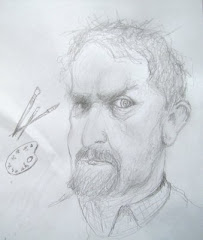
Would YOU pose for this man???
Exhibition Poster

Catterline Event, 2011
Oil Painting by Jim Tait
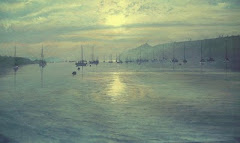
Helford River, Cornwall
Oil Painting by Jim Tait
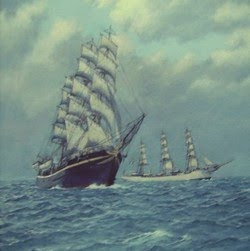
Full-riggers "Georg Stage" and "Danmark"
Other Recent Works
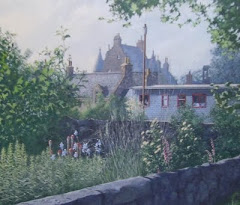
Fordyce Castle and Village

Hay's Dock, Lerwick

Shetland-model Boats at Burravoe, Yell
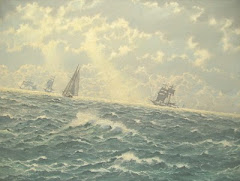
Tall Ships Seascape

The Tour Boat "Dunter III", with Gannets, off Noss
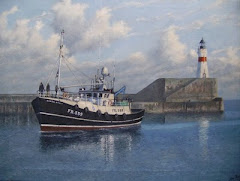
The "Karen Ann II" entering Fraserburgh harbour
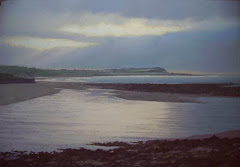
Summer Evening, Boyndie Bay
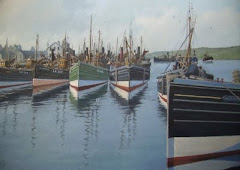
1930s Lerwick Harbour

Johnshaven Harbour
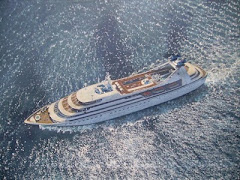
"Seabourn Legend"
Greeting Cards!

Now Available in Packs of Five or in Assorted Sets of Four
Sunday, 4 May 2014
Sunday, 13 April 2014
HALF A WORLD APART
Here's a couple of seascape oil paintings, both featuring pelagic fishing vessels, but from completely different stages of development of this fishery. Both pictures were commissions completed within the last few months.
The first is of the Gamrie steam drifter "Daisy Bank" (BF393), wooden-built by W & G Stephen of Banff in 1911. At 86 feet LOA, 35 tons net and 28hp, she was fairly typical of this type of vessel. Apart from her herring fishing career, she also saw Admiralty service in both World Wars, finally being wrecked in 1949. One of her crew was George Mutch, and his grand-daughter, now living in Queensland, Australia, commissioned the work from me.
The second is of the Whalsay pelagic trawler "Research", steel-built and completed at Flekkefjord, Norway in 2003. At 232ft LOA and 2,430 grt, she is a good example of the new style of vessel pursuing the herring and mackerel shoals. The two paintings illustrate how boats have changed in terms of size, power and technology over the last century.
Sunday, 6 April 2014
DA WIRM ATI DA KLIV!
I'll allow you to contemplate on the enigmatic title to this post, which briefly describes my trip "sooth" last weekend. My Northlink discount travel vouchers for 2013/14 were about to lose their validity, so it was perhaps a form of notional thriftiness which precipitated me towards the Holmsgarth ferry terminal on the afternoon of Friday 28th March. The last time I made this move was on Thursday April 4th last year, when my sister got married at Drum castle on the Saturday, so it's been a while.
My brother met me at the Aberdeen terminal on Saturday morning, and we soon were on the main road south of the city. We had no definite plans as to where our journey would take us, beyond Peter's instructions to pick up a couple of trays of bedding plants at the Brechin garden centre. This, then, was where we had our "twaal" cup, Peter bought his plants, and I took a look round the centre, which is well-stocked with kitchen goods as well as garden stuff.
Duly refreshed, we continued southwards, through Forfar before heading further inland to Kirriemuir and Glenisla (places I had never been to before). Here I was surprised by the appearance of a largish lake, which turned out to be the Loch of Lintrathen, the south side of which we skirted to reach the attractive town of Alyth (we were now into Perthshire) and the village of Meigle, before turning northwards towards Forfar again. All of these places had character and beauty about them, and I would need to spend more time in each of them, wandering about with my sketchbook and camera. Sadly there just wasn't time to get any more than a mere flavour-whiff of them on this occasion.
I forgot to mention Aberlemno, between Brechin and Forfar. My brother has an interest in Scottish history, and there are sculpted standing stones, commemmorating early battles, here. They are at the roadside and churchyard , and we stopped on our way south to have a look, but the stones are still clad in their winter protective covers, so they were unavailable for us to view.
Like homing pigeons, we always seem to head for the Panmure Hotel at Edzell for our lunch, and this was where we dined on this occasion too. Then we headed for the coast at Arbroath, and thence northwards. We stopped at Gourdon, where I successfully secured another painting commission at the Harbour Bar (an excellent old-fashioned little pub), then resumed our journey back to Aberdeen, arriving at around 5pm. I checked into the Premier Inn at the Cocket Hat, and reflected on a very enjoyable day. The weather had been cloudy, but this mattered little.
The next day, it was my nephew who had the onerous task of being my travelling companion. Our first stop was the all-night Asda at Brig o' Dee, where he wanted to buy some new footwear. It was my first experience of this colossal (to my eyes!) superstore, and it was certainly an impressive temple to the gods of consumerism. I did my best to play the part of hill-billy uncle to my red-faced nephew, as we passed the racks of women's underclothing which are a hurdle to be negotiated on the way from the front door to the gents' shoes department. "I've got to live in this town!", he hissed in protest.
We headed north out of town, again with no definite plan or itinerary beyond the general direction. At Mintlaw we took a westerly turn, as Kenneth fancied having a look at some of the Moray Firth towns and villages. We stopped at New Pitsligo, which is quite a bit larger than I had previously realised. We visited a little shop, where I bought a few provisions for the boat trip north, had a walk around town and I took a few photographs here.
My nephew wanted to take a look at Macduff, and I couldn't miss the opportunity of introducing him to the spectacular views of Gardenstown on the way. We negotiated the precipitous gradient and hairpin bends of this cliff-clinging village, and stopped for a while at the harbour, where the water was considerably higher than the last time I was here. My camera came in for some more use here. After this, Macduff - an attractive town in its own right - was a bit of an anti-climax, and we turned south at the Deveron bridge. I took a wistful look across the river at Duff House, which looked as magnificent as ever, but it is sadly no longer in the business of holding art exhibitions. The high point of my career was definitely my 2009 show here, and I only wish I could repeat the experience, but it doesn't look as if that will be possible.
We headed down the A947, through Turriff and Fyvie, and turned left at Oldmeldrum, to reach Ellon in time for our lunch at the New Mill Hotel and the Cornkist Restaurant. Sadly, it being Mothering Sunday, that most cynical of consumer-exploiting devices, the restaurant was fully booked, and we had to to slum it at a table in the corner of the public bar, along with the rest of the unwashed and unbooked. In spite of this, the meal was as delicious as ever, my only complaint being that there was too much of it to finish.
Sadly, this was the last meal of my trip, and we headed back to Aberdeen. The weather had been unfortunately cloudy throughout (it had been sunny in Shetland for most of this time!), but the change of scenery had been refreshing, if somewhat obscured in mist. I'd need to spend time in each of the towns we visited, in order to exploit their views and scenes artistically, and there just isn't time to do all of it. All the paintings I've created of such mainland scenes have sold, with the exception of Conzie Castle, where I made the mistake of trying to re-create the spontaneity of a moment in time, which is difficult to do in oils on canvas.
I'm more grateful than I can express to my brother and nephew for their help in these excursions. As the mist-obscured coast of Aberdeenshire and Buchan receded behind the ferry "Hrossey", I turned my mind to the painting jobs in hand, and other matters at home.
The painting at the top of this post is my reworking of an earlier view of Muckle Flugga lighthouse, and the old Yell seine-netter "Halcyon" coming round the most northerly point of the British Isles, heading eastwards from the Atlantic Ocean to the North Sea. The work was a recent commission, and I have more to show you in my next effort here. Have a nice week!
My brother met me at the Aberdeen terminal on Saturday morning, and we soon were on the main road south of the city. We had no definite plans as to where our journey would take us, beyond Peter's instructions to pick up a couple of trays of bedding plants at the Brechin garden centre. This, then, was where we had our "twaal" cup, Peter bought his plants, and I took a look round the centre, which is well-stocked with kitchen goods as well as garden stuff.
Duly refreshed, we continued southwards, through Forfar before heading further inland to Kirriemuir and Glenisla (places I had never been to before). Here I was surprised by the appearance of a largish lake, which turned out to be the Loch of Lintrathen, the south side of which we skirted to reach the attractive town of Alyth (we were now into Perthshire) and the village of Meigle, before turning northwards towards Forfar again. All of these places had character and beauty about them, and I would need to spend more time in each of them, wandering about with my sketchbook and camera. Sadly there just wasn't time to get any more than a mere flavour-whiff of them on this occasion.
I forgot to mention Aberlemno, between Brechin and Forfar. My brother has an interest in Scottish history, and there are sculpted standing stones, commemmorating early battles, here. They are at the roadside and churchyard , and we stopped on our way south to have a look, but the stones are still clad in their winter protective covers, so they were unavailable for us to view.
Like homing pigeons, we always seem to head for the Panmure Hotel at Edzell for our lunch, and this was where we dined on this occasion too. Then we headed for the coast at Arbroath, and thence northwards. We stopped at Gourdon, where I successfully secured another painting commission at the Harbour Bar (an excellent old-fashioned little pub), then resumed our journey back to Aberdeen, arriving at around 5pm. I checked into the Premier Inn at the Cocket Hat, and reflected on a very enjoyable day. The weather had been cloudy, but this mattered little.
The next day, it was my nephew who had the onerous task of being my travelling companion. Our first stop was the all-night Asda at Brig o' Dee, where he wanted to buy some new footwear. It was my first experience of this colossal (to my eyes!) superstore, and it was certainly an impressive temple to the gods of consumerism. I did my best to play the part of hill-billy uncle to my red-faced nephew, as we passed the racks of women's underclothing which are a hurdle to be negotiated on the way from the front door to the gents' shoes department. "I've got to live in this town!", he hissed in protest.
We headed north out of town, again with no definite plan or itinerary beyond the general direction. At Mintlaw we took a westerly turn, as Kenneth fancied having a look at some of the Moray Firth towns and villages. We stopped at New Pitsligo, which is quite a bit larger than I had previously realised. We visited a little shop, where I bought a few provisions for the boat trip north, had a walk around town and I took a few photographs here.
My nephew wanted to take a look at Macduff, and I couldn't miss the opportunity of introducing him to the spectacular views of Gardenstown on the way. We negotiated the precipitous gradient and hairpin bends of this cliff-clinging village, and stopped for a while at the harbour, where the water was considerably higher than the last time I was here. My camera came in for some more use here. After this, Macduff - an attractive town in its own right - was a bit of an anti-climax, and we turned south at the Deveron bridge. I took a wistful look across the river at Duff House, which looked as magnificent as ever, but it is sadly no longer in the business of holding art exhibitions. The high point of my career was definitely my 2009 show here, and I only wish I could repeat the experience, but it doesn't look as if that will be possible.
We headed down the A947, through Turriff and Fyvie, and turned left at Oldmeldrum, to reach Ellon in time for our lunch at the New Mill Hotel and the Cornkist Restaurant. Sadly, it being Mothering Sunday, that most cynical of consumer-exploiting devices, the restaurant was fully booked, and we had to to slum it at a table in the corner of the public bar, along with the rest of the unwashed and unbooked. In spite of this, the meal was as delicious as ever, my only complaint being that there was too much of it to finish.
Sadly, this was the last meal of my trip, and we headed back to Aberdeen. The weather had been unfortunately cloudy throughout (it had been sunny in Shetland for most of this time!), but the change of scenery had been refreshing, if somewhat obscured in mist. I'd need to spend time in each of the towns we visited, in order to exploit their views and scenes artistically, and there just isn't time to do all of it. All the paintings I've created of such mainland scenes have sold, with the exception of Conzie Castle, where I made the mistake of trying to re-create the spontaneity of a moment in time, which is difficult to do in oils on canvas.
I'm more grateful than I can express to my brother and nephew for their help in these excursions. As the mist-obscured coast of Aberdeenshire and Buchan receded behind the ferry "Hrossey", I turned my mind to the painting jobs in hand, and other matters at home.
The painting at the top of this post is my reworking of an earlier view of Muckle Flugga lighthouse, and the old Yell seine-netter "Halcyon" coming round the most northerly point of the British Isles, heading eastwards from the Atlantic Ocean to the North Sea. The work was a recent commission, and I have more to show you in my next effort here. Have a nice week!
Sunday, 23 March 2014
THE OLD "EARL"
The first "Earl of Zetland" was launched on the Clyde in 1877. At only 186 grt, she wasn't big, but she provided a lifeline service for the next 60 years, ferrying passengers, cargo and livestock between Lerwick and the north isles of Shetland.
In 1938, she was replaced on the route by the new "Earl of Zetland", but, on the outbreak of war the following year, the new ship was commandeered to perform Admiralty duties. The old "Earl" was brought back into service on her old run for the rest of the war years, skippered by my uncle Adam Tait for this part of her long career.
My painting shows her steaming south through Linga Sound in a fresh northerly breeze. The viewpoint is from Whalsay, looking westwards. The original painting, with A4 and A3 limited edition giclee prints also available, can be purchased through the Gallery Shop pages of my website www.tait-gallery.co.uk
In 1938, she was replaced on the route by the new "Earl of Zetland", but, on the outbreak of war the following year, the new ship was commandeered to perform Admiralty duties. The old "Earl" was brought back into service on her old run for the rest of the war years, skippered by my uncle Adam Tait for this part of her long career.
My painting shows her steaming south through Linga Sound in a fresh northerly breeze. The viewpoint is from Whalsay, looking westwards. The original painting, with A4 and A3 limited edition giclee prints also available, can be purchased through the Gallery Shop pages of my website www.tait-gallery.co.uk
OVERTON, LEVENWICK
Before my mother moved into the Overtonlea Care Centre on 30th April 2012, I'd scarcely been down the road through Levenwick since my youth (and that's a long time ago!). I have vague childhood memories of family picnics on the sandy beach below the hill. From there we looked right across the bay at our home in Sandwick - it was far quicker by boat than by car over the miles of winding road along the hillsides.
There was one other occasion, back in 2004, when I visited my web designer, Roy Longmuir, at his home in Levenwick. It was an exciting time for me, as we were setting up my website and The Tait Gallery was going online for the first time. The photograph of me on the home page article "About the Artist" was taken that day at the front of Roy's house.
The view in the painting shown above is from a little further down the Overton road, looking towards Sandwick, which has changed practically beyond recognition since my formative years. One of the attractive things about Levenwick is the predominance of old -fashioned white-washed "but-and-ben" houses which still cling to to the steep hillside, and the more modern dwellings seem to be placed so as not to detract too much from from the traditional flavour of the scene. In other parts of Shetland, building has been much less sensitive in this way, with clumps of wooden kit houses and glass-and-concrete monstrosities dominating the landscape. I've grown rather fond of Levenwick, and not just because it is now my mother's home.
The painting, and limited edition giclee prints (both A3 and A4) are available through the Gallery Shop on my website www.tait-gallery.co.uk.
There was one other occasion, back in 2004, when I visited my web designer, Roy Longmuir, at his home in Levenwick. It was an exciting time for me, as we were setting up my website and The Tait Gallery was going online for the first time. The photograph of me on the home page article "About the Artist" was taken that day at the front of Roy's house.
The view in the painting shown above is from a little further down the Overton road, looking towards Sandwick, which has changed practically beyond recognition since my formative years. One of the attractive things about Levenwick is the predominance of old -fashioned white-washed "but-and-ben" houses which still cling to to the steep hillside, and the more modern dwellings seem to be placed so as not to detract too much from from the traditional flavour of the scene. In other parts of Shetland, building has been much less sensitive in this way, with clumps of wooden kit houses and glass-and-concrete monstrosities dominating the landscape. I've grown rather fond of Levenwick, and not just because it is now my mother's home.
The painting, and limited edition giclee prints (both A3 and A4) are available through the Gallery Shop on my website www.tait-gallery.co.uk.
Labels:
cottages,
giclee prints,
Landscape painting,
Levenwick,
Shetland scene
Monday, 17 March 2014
A PAIN IN THE NECK!
Osteoporosis? Cervical Spondylosis? Osteo-arthritis? Something else equally horrible? I don't know what the medical term for it might be - all I know is that it is a pain in the neck, and I've had it since last summer! It's been a right old nuisance, affecting my artwork, my writing and practically every other sphere of activity in which I indulge.
For some time leading up to last summer, I'd noticed that my neck became painful when I was working at waist-height while standing. Things like washing dishes, setting up my stalls or preparing food seemed to bring on an ache in the back of my neck. When this occurred I would sit down for five minutes, the ache would go away, and I'd carry on as before - you know how you do! But then, at the beginning of July, things changed.
After clearing up from one of my Saturday stalls, I developed serious pain, along with extreme stiffness, which meant that my head was pointing downwards most of the time. I had difficulty lifting it up, and I couldn't raise it at all when walking. I went along with my head in a ridiculous stoop, unable to see much more than ten yards ahead of me.. When I first presented my problem at the Lerwick Health centre, the doctor told me there was little that could be done about it. He couldn't prescribe anti-inflammatories for the pain, as I was already on medication for hypertension, and he gave me a programme of neck exercises, supposedly to make my neck more supple. Surprisingly he didn't even suggest an X-ray. I continued to look at my feet as I walked, now utterly depressed at the thought of my condition possibly being permanent. Life continued to be a pain in the neck!
Even shaving was a problem - I couldn't get my head raised sufficiently to get the electric razor underneath my chin. I went to see the chiropractor, and, through him, I paid for my own X-ray. This showed a bit of wear and tear on the spine, with a couple of discs getting spongy, but little obvious damage in the neck area. The chiropractor beat me up on a regular basis, but this only had the effect of shifting the pain around, as did the sterling efforts of the masseuse, who also had a go at solving my problem. I now dreaded going to bed at night, as the first five minutes after my head hit the pillow were excruciatingly painful, before the pain settled down enough to allow some fitful sleep.
The doctor had reckoned that the pain was due to my work practice, and this may be true. Most of my painting is done while seated at a table, with the canvas lying flat. Certainly, holding my head concentrated in one position for some time, whether painting or writing, made my neck very stiff. I tried a table easel, but this made very little difference. It was the tension in my neck, as I held my head steady to concentrate on the brushwork, which seemed to cause the pain and stiffness. All attempts at artwork now ceased.
What is normally a rare treat for me, and an opportunity which only comes my way once every five years or so, took place on the first Saturday in August. I'd been invited to be one of the panel of arts and crafts judges at the Voe Show. The weather was beautiful - breezy and sunny - and what should have been an absolute delight was completely spoiled by my pain. The three hours of deciding what should get the honours among the many excellent exhibits was done through a dark veil of my own discomfort, which I was trying my best not to transmit to my fellow judges and helpers. It made a chore out of what is usually a pleasure and inspiration.
In September, having had two months of barely tolerable pain (and a growing waiting list of unfulfilled painting commissions), I decided to have another go at trying to get someone interested in my condition at the Lerwick Health Centre. And this time I met a doctor who took immediate command of the situation, and my life changed almost instantaneously. She prescribed me an anti-inflammatory which was not in conflict with my other medication, and which substantially reduced the pain within a couple of days. She put me in touch with hospital physiotherapists who helped me further.. She entered into an in-depth investigation of my problem, taking blood samples which revealed calcium deficiency, amongst other things, and which a daily intake of Vitamin D is now addressing. I am now back doing artwork, and my embarrassing waiting list has diminished greatly. Some of my recent efforts will be appearing here in the coming days. It's so nice to be back!
The neck is still a bit stiff, and I'm having a bone scan at Aberdeen Royal Infirmary next month. But the stiffness and pain are getting gradually less and I now hold my head up in public when out walking. I can look straight ahead of me, and round and about me, once more, and life is getting better again - yippee!
For some time leading up to last summer, I'd noticed that my neck became painful when I was working at waist-height while standing. Things like washing dishes, setting up my stalls or preparing food seemed to bring on an ache in the back of my neck. When this occurred I would sit down for five minutes, the ache would go away, and I'd carry on as before - you know how you do! But then, at the beginning of July, things changed.
After clearing up from one of my Saturday stalls, I developed serious pain, along with extreme stiffness, which meant that my head was pointing downwards most of the time. I had difficulty lifting it up, and I couldn't raise it at all when walking. I went along with my head in a ridiculous stoop, unable to see much more than ten yards ahead of me.. When I first presented my problem at the Lerwick Health centre, the doctor told me there was little that could be done about it. He couldn't prescribe anti-inflammatories for the pain, as I was already on medication for hypertension, and he gave me a programme of neck exercises, supposedly to make my neck more supple. Surprisingly he didn't even suggest an X-ray. I continued to look at my feet as I walked, now utterly depressed at the thought of my condition possibly being permanent. Life continued to be a pain in the neck!
Even shaving was a problem - I couldn't get my head raised sufficiently to get the electric razor underneath my chin. I went to see the chiropractor, and, through him, I paid for my own X-ray. This showed a bit of wear and tear on the spine, with a couple of discs getting spongy, but little obvious damage in the neck area. The chiropractor beat me up on a regular basis, but this only had the effect of shifting the pain around, as did the sterling efforts of the masseuse, who also had a go at solving my problem. I now dreaded going to bed at night, as the first five minutes after my head hit the pillow were excruciatingly painful, before the pain settled down enough to allow some fitful sleep.
The doctor had reckoned that the pain was due to my work practice, and this may be true. Most of my painting is done while seated at a table, with the canvas lying flat. Certainly, holding my head concentrated in one position for some time, whether painting or writing, made my neck very stiff. I tried a table easel, but this made very little difference. It was the tension in my neck, as I held my head steady to concentrate on the brushwork, which seemed to cause the pain and stiffness. All attempts at artwork now ceased.
What is normally a rare treat for me, and an opportunity which only comes my way once every five years or so, took place on the first Saturday in August. I'd been invited to be one of the panel of arts and crafts judges at the Voe Show. The weather was beautiful - breezy and sunny - and what should have been an absolute delight was completely spoiled by my pain. The three hours of deciding what should get the honours among the many excellent exhibits was done through a dark veil of my own discomfort, which I was trying my best not to transmit to my fellow judges and helpers. It made a chore out of what is usually a pleasure and inspiration.
In September, having had two months of barely tolerable pain (and a growing waiting list of unfulfilled painting commissions), I decided to have another go at trying to get someone interested in my condition at the Lerwick Health Centre. And this time I met a doctor who took immediate command of the situation, and my life changed almost instantaneously. She prescribed me an anti-inflammatory which was not in conflict with my other medication, and which substantially reduced the pain within a couple of days. She put me in touch with hospital physiotherapists who helped me further.. She entered into an in-depth investigation of my problem, taking blood samples which revealed calcium deficiency, amongst other things, and which a daily intake of Vitamin D is now addressing. I am now back doing artwork, and my embarrassing waiting list has diminished greatly. Some of my recent efforts will be appearing here in the coming days. It's so nice to be back!
The neck is still a bit stiff, and I'm having a bone scan at Aberdeen Royal Infirmary next month. But the stiffness and pain are getting gradually less and I now hold my head up in public when out walking. I can look straight ahead of me, and round and about me, once more, and life is getting better again - yippee!
Labels:
artwork,
discomfort,
inability to work,
medical issues,
osteoporosis,
pain,
work practice,
writing
Sunday, 16 March 2014
THE "GIRL OLIVE" (II)
The Fraserburgh dual-purpose boat "Girl Olive" (FR369), rigged for drift-net fishing, leaves her home port to look for the herring shoals. She holds the record for the fastest build ever of this class of 70-foot vessel. From the laying of her keel in early November of 1952, it took only six weeks to launch her fully-rigged. She sailed the same day, and landed fish that night! Nowadays it takes that long to undergo the regulatory inspections!
This commissioned work was for a client in Australia. I completed it finally in October, after a few months lay-off due to being poorly. More on that subject shortly!
This commissioned work was for a client in Australia. I completed it finally in October, after a few months lay-off due to being poorly. More on that subject shortly!
Subscribe to:
Comments (Atom)








